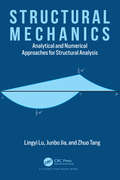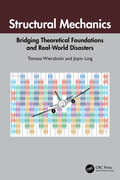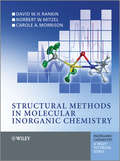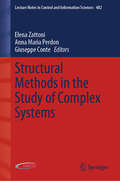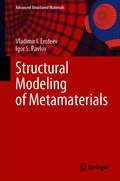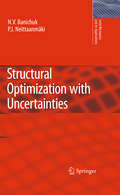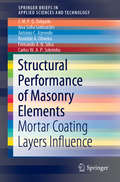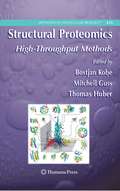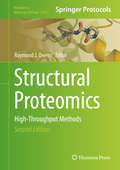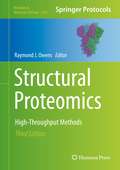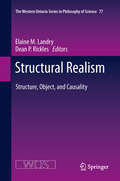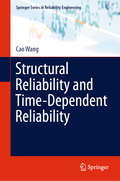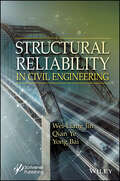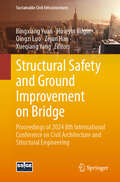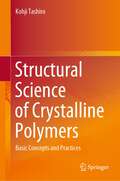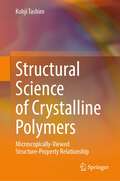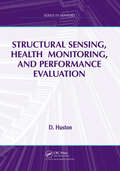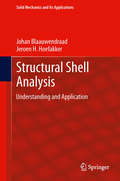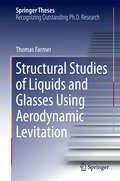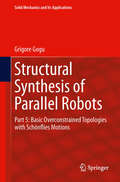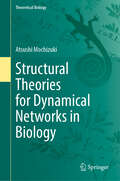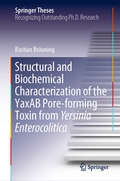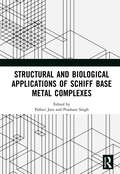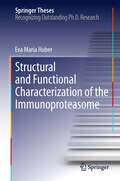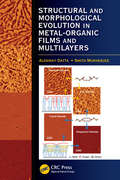- Table View
- List View
Structural Mechanics: Analytical and Numerical Approaches for Structural Analysis
by Junbo Jia Lingyi Lu Zhuo TangThis book covers both standard and advanced topics of structural mechanics. Standard subjects covered include geometric stability, forces and displacements of statically determinate structures, force and displacement method, and influence lines. Advanced topics include matrix displacement method, dynamics of structures, and limit loading. The book serves both as a classroom textbook and as a permanent engineering reference. It is written in such a way that it can be followed by anyone with a basic knowledge of classical and material mechanics.
Structural Mechanics: Bridging Theoretical Foundations and Real-World Disasters
by Tomasz Wierzbicki Jiayin LingStructural Mechanics covers three different aspects of modern engineering: the foundation of structural mechanics, the solution to urgent industrial problems, and the reconstruction of major accidents. This book offers six case studies that teach how to identify the most important phase of the collapse or fracture of a complex system, develop a simple mathematically tractable model, and offer a discussion of the analytical and numerical solutions. This book originated from the lecture notes of Professor Tomasz Wierzbicki who taught at MIT and Stanford University. The notes were amended and improved many times over the years to provide a link between rigorous theoretical foundations with solutions to important engineering problems. The book discusses complex man-made structures under accidental impact or explosive loads, resulting in the loss of life and/or extensive property, infrastructural, and environmental damage. The book deals with reconstructing the sequence of events of such accidents from the structural point of view. The book is not restricted to the accident reconstruction only - concepts and solutions of the elasticity, advance plasticity and ductile fracture were used throughout the reconstruction of the accidents. The additional 17 lectures provide theoretical foundations for the elastic structures, plastic plates and shells, and ductile fracture. Not only is this an essential textbook for graduate students studying structural mechanics, it is also relevant to industry professionals, researchers, and academics in the field of engineering.
Structural Methods in Molecular Inorganic Chemistry
by Carole Morrison D. W. Rankin Norbert MitzelDetermining the structure of molecules is a fundamental skill that all chemists must learn. Structural Methods in Molecular Inorganic Chemistry is designed to help readers interpret experimental data, understand the material published in modern journals of inorganic chemistry, and make decisions about what techniques will be the most useful in solving particular structural problems.Following a general introduction to the tools and concepts in structural chemistry, the following topics are covered in detail:* computational chemistry* nuclear magnetic resonance spectroscopy * electron paramagnetic resonance spectroscopy * Mössbauer spectroscopy * rotational spectra and rotational structure * vibrational spectroscopy * electronic characterization techniques* diffraction methods * mass spectrometryThe final chapter presents a series of case histories, illustrating how chemists have applied a broad range of structural techniques to interpret and understand chemical systems.Throughout the textbook a strong connection is made between theoretical topics and the real world of practicing chemists. Each chapter concludes with problems and discussion questions, and a supporting website contains additional advanced material.Structural Methods in Molecular Inorganic Chemistry is an extensive update and sequel to the successful textbook Structural Methods in Inorganic Chemistry by Ebsworth, Rankin and Cradock. It is essential reading for all advanced students of chemistry, and a handy reference source for the professional chemist.
Structural Methods in the Study of Complex Systems (Lecture Notes in Control and Information Sciences #482)
by Elena Zattoni Anna Maria Perdon Giuseppe ConteStructural Methods in the Study of Complex Systems helps the reader respond to the challenge of mastering complexity in systems and control. The book details the fundamental control problems arising from complex dynamical systems and shows how they can be tackled effectively by means of methods developed from graph theory, differential algebra and geometric approaches. These “structural methods” produce abstractions that fit a wide variety of applications by taking advantage of their intrinsic focus on the essential characteristics of dynamical systems, their geometric perspective and visual representation, and their algebraic formalization and ability to generate algorithmic frameworks to complement the theoretical treatment. The original work and latest achievements of the contributors, expanding on material presented at a workshop organized to coincide with the 2018 European Control Conference will assist systems and control scientists interested in developing theoretical and computational tools to solve analysis and synthesis problems involving complex dynamical systems. The contributions provide a comprehensive picture of available results along with a stimulating view of possible directions for future investigations in the field. Emphasis is placed on methods with solid computational background and on specific engineering applications so that readers from both theoretical and practical backgrounds will find this collection of use.
Structural Modeling of Metamaterials (Advanced Structured Materials #144)
by Igor S. Pavlov Vladimir I. ErofeevThis book discusses the theoretical foundations of the structural modeling method applied to metamaterials. This method takes into account the parameters of the crystal lattice, the size of the medium particles, as well as their shape and constants of force interactions between them. It provides mathematical models of metamaterials that offer insights into the qualitative influence of the local structure on the effective elastic moduli of the considered medium and into performing theoretical estimations of these quantities. This book is useful for researchers working in the fields of solid mechanics, physical acoustics, and condensed matter physics, as well as for graduate and postgraduate students studying mathematical modeling methods.
Structural Optimization with Uncertainties
by Pekka Neittaanmäki N. V. BanichukThis monograph is devoted to the exposition of new ways of formulating problems of structural optimization with incomplete information and techniques of solution. Research results concerning the optimum shape and structural properties of the bodies subjected to external loadings are recapitulated. Problems of optimal design with incomplete information, accounting for the interaction between the structure and its environment, properties of materials, existence of initial damages and damage accumulation are studied. This volume treats overcoming the corresponding mathematical difficulties caused by raising local functionals. Most of the book is devoted to the minimax approach using worst case scenarios, i.e. the so-called guaranteed approach. However, the probabilistic approach, that does not guarantee the result, is also described in the monograph, because it gives more "optimistic" results. Also, the mixed probabilistic guaranteed approach is discussed and applied for the solution of structural optimization problems with uncertainties.
Structural Performance of Masonry Elements: Mortar Coating Layers Influence (SpringerBriefs in Applied Sciences and Technology)
by Ana Sofia Guimarães António C. Azevedo Romilde A. Oliveira J. M. Delgado Fernando A.N. Silva Carlos W.A.P. SobrinhoThis book discusses the main mechanical features of masonry buildings and the peculiarities that affect their structural behaviour. It also examines technical information regarding accidents that have occurred in recent years in the Metropolitan Region of Recife, along with the historical records of these events, followed by indications of the causes for the collapse. The book offers extensive experimental results that make it possible to identify the contribution of several mortar rendering layers to the load capacity of the tested specimens. Lastly, it explores the factors that influenced the load capacity of the tested specimens.
Structural Proteomics
by Mitchell Guss Bostjan Kobe Thomas HuberThe objective of this volume is to provide readers with a current view of all aspects of the 'pipeline' that takes protein targets to structures and how these have been optimised. This volume includes chapters describing, in-depth, the individual steps in the Structural Genomics pipeline, as well as less detailed overviews of individual Structural Genomics initiatives. It is the first book of protocols to cover techniques in a new and emerging field.
Structural Proteomics
by Raymond J. OwensThis updated and expanded volume reflects the current state of the structural protein field with improved and refined protocols that have been applied to particularly challenging proteins, notably integral membrane proteins and multi-protein complexes. Structural Proteomics: High-Throughput Methods, Second Edition begins by exploring the resources available for curation, annotation, and structure prediction in silico, and continues with methods for sample preparation of both proteins and crystals, as well as structural characterization techniques. Written for the highly successful Methods in Molecular Biology series, chapters include introductions to their respective topics, lists of the necessary materials and reagents, step-by-step, readily reproducible laboratory protocols, and tips on troubleshooting and avoiding known pitfalls. Practical and up-to-date, Structural Proteomics: High-Throughput Methods, Second Edition will aid researchers in expanding our knowledge of this vital and expansive area of protein science.
Structural Proteomics: High-Throughput Methods (Methods in Molecular Biology #2305)
by Raymond J. OwensThis updated and expanded volume reflects the current state of the structural protein field with improved and refined protocols that have been applied to particularly challenging proteins. Beginning with a section on structural bioinformatics, the book continues with sections covering the challenge of producing high quality samples for structural studies, particularly mammalian membrane proteins and protein complexes, as well as protocols for structure determination, including the use of electrons in structural biology and more. Written for the highly successful Methods in Molecular Biology series, chapters include introductions to their respective topics, lists of the necessary materials and reagents, step-by-step, readily reproducible laboratory protocols, and tips on troubleshooting and avoiding known pitfalls. Authoritative and up-to-date, Structural Proteomics: High-Throughput Methods, Third Edition will aid researchers in expanding our knowledge of this vital and expansive area of protein science.Chapter 9 is available open access under a CC BY 4.0 license.
Structural Realism
by Dean Rickles Elaine LandryStructural realism has rapidly gained in popularity in recent years, but it has splintered into many distinct denominations, often underpinned by diverse motivations. There is, no monolithic position known as 'structural realism,' but there is a general convergence on the idea that a central role is to be played by relational aspects over object-based aspects of ontology. What becomes of causality in a world without fundamental objects? In this book, the foremost authorities on structural realism attempt to answer this and related questions: 'what is structure?' and 'what is an object?' Also featured are the most recent advances in structural realism, including the intersection of mathematical structuralism and structural realism, and the latest treatments of laws and modality in the context of structural realism. The book will be of interest to philosophers of science, philosophers of physics, metaphysicians, and those interested in foundational aspects of science.
Structural Reliability and Time-Dependent Reliability (Springer Series in Reliability Engineering)
by Cao WangThis book provides structural reliability and design students with fundamental knowledge in structural reliability, as well as an overview of the latest developments in the field of reliability engineering. It addresses the mathematical formulation of analytical tools for structural reliability assessment. This book offers an accessible introduction to structural reliability assessment and a solid foundation for problem-solving. It introduces the topic and background, before dealing with probability models for random variables. It then explores simulation techniques for single random variables, random vectors consisting of different variables, and stochastic processes. The book addresses analytical approaches for structural reliability assessment, including the reliability models for a single structure and those for multiple structures, as well as discussing the approaches for structural time-dependent reliability assessment in the presence of discrete and continuous load processes. This book delivers a timely and pedagogical textbook, including over 170 worked-through examples, detailed solutions, and analytical tools, making it of interest to a wide range of graduate students, researchers, and practitioners in the field of reliability engineering.
Structural Reliability in Civil Engineering
by Qian Ye Yong Bai Wei-Liang JinStructural Reliability in Civil Engineering gives essential insights into the complexities of uncertainty in engineered structures, along with practical examples and advanced methods, making it an invaluable resource for both theory and real-world application in your civil engineering projects. Uncertainties are associated with the design, evaluation, and dynamic analysis of engineered structures. Structural Reliability in Civil Engineering introduces a developmental overview and basic concepts of reliability theory, uncertainty analysis methods, reliability calculation methods, numerical simulation methods of reliability, system reliability analysis methods, time-varying structural reliability, load and load combination methods, the application of reliability in specifications, and the application of reliability theory in practical engineering. This book not only discusses reliability theory in civil structural engineering but also presents valuable examples to illustrate the application of reliability theory to practical questions and comprehensively elaborates on some theories related to reliability from a brand-new perspective.
Structural Safety and Ground Improvement on Bridge: Proceedings of 2024 8th International Conference on Civil Architecture and Structural Engineering (Sustainable Civil Infrastructures)
by Bingxiang Yuan Hüseyin Bilgin Qingzi Luo Zejun Han Xueqiang YangThis book provides readers with the most advanced research on bridge engineering structures and high performance concrete applications in China. Bridges as an important part of transportation facilities, its structural design and safety has been more concerned about the content. Especially in modern times, because of the needs of human travel and urban development, the structure of the bridge has also seen many innovations. However, there are consequent concerns about structural safety and stability in whole-life use. China, as the country with the largest increase in bridge construction in recent years, has shown many famous bridge projects to the world. These include the Hong Kong-Zhuhai-Macao Bridge (HZMB), which spans Guangdong, Hong Kong and Macao, the Zhang Jinggao Yangtze River Bridge in Jiangsu province, a suspension bridge with a length of more than 2,000 meters, and the Beipanjiang Railway Cable-stayed Bridge, which has the highest vertical distance from the ground of 565 meters, to name a few. In the face of complex terrain and geological conditions, Chinese bridge engineers have conducted many researches and applied to various engineering cases to finalize the construction of various bridge projects. Therefore, Chinese engineers and scholars have accumulated a lot of construction experience and research results. And we believe that these experiences and results are valuable and effective for the world bridge engineering field. The book gathers selected papers in 2024 8th International Conference on Civil Architecture and Structural Engineering, focuses on structural safety and high-performance concrete in bridges. We hope to share with bridge engineers around the world the latest experiences in bridge construction and structural safety from China, as well as the research and exploration of the application of high-performance concrete in bridge stability.
Structural Science of Crystalline Polymers: Basic Concepts and Practices
by Kohji TashiroThis book focuses on the modern development of techniques for analysis of the hierarchical structure of polymers from both the experimental and theoretical points of view. Starting with molecular and crystal symmetry, the author explains fundamental and professional methods, such as wide- and small-angle X-ray scattering, neutron diffraction, electron diffraction, FTIR and Raman spectroscopy, NMR, and synchrotron radiation. In addition, the author explains another indispensable method, computer simulation, which includes energy calculation, lattice dynamics, molecular dynamics, and quantum chemistry. These various methods are described in a systematic way so that the reader can utilize them for the purpose of 3D structure analysis of polymers. Not only such analytical knowledge but also the preparation techniques of samples necessary for these measurements and the methods of analyzing the experimental data collected in this way are given in a concrete manner. Examples are offered to help master the principles of how to clarify the static structures and dynamic structural changes in the phase transitions of various kinds of crystalline polymers that are revealed by these novel methods. The examples are quite useful for readers who want to apply these techniques in finding practical solutions to concrete problems that are encountered in their own research. The principal audience for this book is made up of young professional researchers including those working in industry, but it can also be used as an excellent reference for graduate-level students. This book is the first volume of a two-volume set with Structural Science of Crystalline Polymers: A Microscopically Viewed Structure–Property Relationship being the second volume by the same author.
Structural Science of Crystalline Polymers: Microscopically-Viewed Structure-Property Relationship
by Kohji TashiroThis book focuses on methods of how to understand the relationship between the structure and physical properties of polymers from the microscopic point of view on the basis of experimental and theoretical methodologies. It is the second volume of a two volume set with Structural Science of Crystalline Polymers. The first volume of the series, “Structural Science of Crystalline Polymers: Basic Concepts and Practices” describes the details of techniques for analysis of the hierarchical structure of crystalline polymers from both the experimental and theoretical points of view. Readers of the first volume who master the concrete techniques and concepts necessary for the analysis of the structure of polymers are now invited to begin this second volume. The methods introduced in this book are useful not only for understanding the physical properties of crystalline regions but also for interpreting the bulk properties of polymer materials from the 3D structural point of view. Forthis purpose, a concrete description is provided so that readers can use the theory or the program in the actual interpretation of physical properties. The physical properties of polymers are intimately related to the structural evolution in the crystallization process and also the structural changes in the samples subjected to an external field. Concrete methods and examples are introduced for these studies, making the book a useful and practical guide for young professional researchers, including those working in industry. At the same time, it can also be used as an excellent reference for graduate-level students.
Structural Sensing, Health Monitoring, and Performance Evaluation (Series in Sensors)
by D. HustonStructural health monitoring (SHM) uses one or more in situ sensing systems placed in or around a structure, providing real-time evaluation of its performance and ultimately preventing structural failure. Although most commonly used in civil engineering, such as in roads, bridges, and dams, SHM is now finding applications in other engineering envir
Structural Shell Analysis: Understanding and Application
by Johan Blaauwendraad Jeroen H. HoefakkerThe mathematical description of the properties of a shell is much more elaborate than those of beam and plate structures. Therefore many engineers and architects are unacquainted with aspects of shell behaviour and design, and are not familiar with sufficiently reliable shell theories for the different shell types as derived in the middle of the 20th century. Rather than contributing to theory development, this university textbook focuses on architectural and civil engineering schools. Of course, practising professionals will profit from it as well. The book deals with thin elastic shells, in particular with cylindrical, conical and spherical types, and with elliptic and hyperbolic paraboloids. The focus is on roofs, chimneys, pressure vessels and storage tanks. Special attention is paid to edge bending disturbance zones, which is indispensable knowledge in FE meshing. A substantial part of the book results from research efforts in the mid 20th century at Delft University of Technology. As such, it is a valuable addition to the body of shell research literature of continuing importance. This work can be used for university courses. It also shows professionals how to perform manual calculations of the main force flow in shell structures, and provides guidance for structural engineers estimating stresses and deformations.
Structural Studies of Liquids and Glasses Using Aerodynamic Levitation
by Thomas FarmerThis thesis presents neutron scattering data that contribute to the understanding of four distinct areas of condensed matter physics, including iso-compositional liquid-liquid phase transitions and the glass formation in rare earth doped BaTi2O5. In situ aerodynamic levitation with laser heating was combined with neutron scattering in order to study both liquid-liquid phase transitions in (Y2O3)x(Al2O3)1-x and the atomic and magnetic ordering in liquid Invar. Among several significant results, obtained in this case from small angle neutron scattering, was the absence of a phase transition across a range of temperatures and compositions in the yttria aluminates As these are a principal system in which liquid-liquid phase transitions have been hypothesized, this is an important contribution in a contentious area.
Structural Synthesis of Parallel Robots
by Grigore GoguThis book represents the fifth part of a larger work dedicated to the structural synthesis of parallel robots. The originality of this work resides in the fact that it combines new formulae for mobility, connectivity, redundancy and overconstraints with evolutionary morphology in a unified structural synthesis approach that yields interesting and innovative solutions for parallel robotic manipulators. This is the first book on robotics that presents solutions for coupled, decoupled, uncoupled, fully-isotropic and maximally regular robotic manipulators with Schönflies motions systematically generated by using the structural synthesis approach proposed in Part 1. Overconstrained non-redundant/overactuated/redundantly actuated solutions with simple/complex limbs are proposed. Many solutions are presented here for the first time in the literature. The author had to make a difficult and challenging choice between protecting these solutions through patents and releasing them directly into the public domain. The second option was adopted by publishing them in various recent scientific publications and above all in this book. In this way, the author hopes to contribute to a rapid and widespread implementation of these solutions in future industrial products.
Structural Theories for Dynamical Networks in Biology (Theoretical Biology)
by Atsushi MochizukiThis textbook provides an introduction to theoretical biology using specific topics and explains the main mathematical methods. The book also introduces the &“structural theories&” developed by the author and his colleagues as new theoretical methods. Structural theories are mathematical theories that determine key aspects of the behavior of dynamical systems from network information alone. The book details the practical applications of these methods across several biological network systems and shows that they are practically useful for analyzing the behaviors of biological systems. The first half of the book focuses on the dynamics that arise from the regulation of biomolecular activity, such as gene expression and protein modification. The second half of the book approaches the understanding of the dynamics of complex systems composed of many biomolecules. Each chapter covers current and important topics in biological research, and its description of how biological phenomena are theoretically elucidated effectively conveys the importance and appeal of mathematical methods. This book is not only a comprehensive textbook on theoretical biology, but also a study guide for learning mathematical methods. It also serves as a specialized reference for systematically learning new mathematical theories. The &“Mathematical Methods&” section at the end of each chapter offers a concise summary and facilitates efficient learning for readers, along with the exercises. Target readers of this book are from upper undergraduate students to senior researchers interested in the dynamics of complex network systems in biology. It appeals to both mathematical and experimental biologists, as well as chemists and physicists.
Structural and Biochemical Characterization of the YaxAB Pore-forming Toxin from Yersinia Enterocolitica (Springer Theses)
by Bastian BräuningThis book discusses the decoding of the lytic mechanism of an α-helical pore-forming toxin, YaxAB, composed of two different subunits. Pore-forming toxins (PFTs) are among the most common bacterial toxins. They are produced by a variety of pathogens, which infect a wide range of organisms including plants, insects and humans. Yet the maturation of these particles and the structural changes required for pore formation are still poorly understood for many PFT families. Using a diverse panel of biochemical and structural techniques, including X-ray crystallography and cryo-electron microscopy, Dr. Bräuning and colleagues have succeeded in identifying the mechanistic contributions of the two toxin components and elucidating the lytic state of the pore complex. The results of this thesis on the YaxAB system are applicable to orthologues from agriculturally relevant insect pathogens, and offer valuable structural and mechanistic insights to inform future bioengineering efforts.
Structural and Biological Applications of Schiff Base Metal Complexes
by Pallavi Jain Prashant SinghCoordination compounds have been well-known for their wide variety of applications for over a century, as well as enhancing the researcher’s interest and concern in evaluating their action mechanism. It is certainly one of the most intensely discussed research topics. Coordination compounds involve different metal-ion-ligand phenomenon. The involved metal ions play a significant role in structural association and functioning of several processes in the genetic and metabolism system. In recent years, Schiff base ligands have gained significant interest and received a keen interest of many researchers. Schiff’s base ligands have been recognized to hold a wide variety of biological and medicinal activities due to the presence of donor atoms. They have proved exceptional pharmalogical actions such as antimicrobial, anti-tuberclosis, antiplatelet, antidiabetic, antiarthritis, antioxidant, anti-inflammatory, anticancer, antiviral, antimalarial, and analgesic. These biologically active Schiff base ligands have also been shown to inhibit enzyme mobilization and, when bound to a metal ion, exhibit enhanced biological activity, making them useful in a number of fields. As a result, metal complexes of Schiff base ligands are gaining popularity due to their unique properties and functionalities. Schiff base complex-based research for educational and industrial purposes is booming, and the number of publications is gradually increasing. Despite these interests, there is currently no detailed book on Schiff base metal complexes that covers the structures, biological activities, and other non-biological perspectives.This book delves into the structures of Schiff base metal complexes, which are critical in assessing the biological viability of any complex. It also highlights their biological significance in pharma and drug discovery like antibacterial, antifungal, anticancer, anti-inflammatory, anti-arthritis, anti-diabetic, antioxidants, anti-proliferative, antitumor, anticancer, antiviral. The fundamentals of metal complexes are described, as well as an up-to-date outline of developments in synthesis, characterization methods, properties- chemical, thermal, optical, structural, and applications. This book also discusses the other applications of Schiff base metal complexes: as sensor (luminescent, electrochemical, and biosensor), as pigments in dying and paint industries, as photocatalyst to improve the degradation rate.Features : This book would be useful for academia, researchers and engineers working in the area of Schiff base and their metal complexes. This book will give an in-depth account of the properties of Schiff base and their metal complexes. This book will discuss the details of synthesis methods for Schiff base and their metal complexes. This book will cover emerging trends in the use of Schiff base metal complexes in the industry. This book will provide an overview of the wider biological applications of Schiff base metal complexes
Structural and Functional Characterization of the Immunoproteasome
by Eva Maria HuberIn this acclaimed thesis, Eva Maria Huber reveals ground-breaking results by elucidating the crystal structure of the murine immunoproteasome in complex with a selective inhibitor. Huber does this by performing multidisciplinary methodologies including X-ray crystallography, fluorescence spectroscopy and mutagenesis experiments. Her exceptional results explore the immunoproteasome complex structures and are of outstanding importance for future scientific research especially in the pharmaceutical industry. These results will enable the functional analysis of individual proteasome subunits and support the development of novel drugs for autoimmune diseases such as multiple sclerosis or rheumatoid arthritis.
Structural and Morphological Evolution in Metal-Organic Films and Multilayers
by Alokmay Datta Smita MukherjeeStructural and Morphological Evolution in Metal-Organic Films and Multilayers presents major results of the authors' work carried out on Langmuir monolayers and Langmuir-Blodgett multilayers. The authors address two important questions:Are metal-organic monolayer systems more like solids or more like liquids?Does a two-dimensional system have diffe
